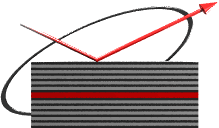Past Projects
|
| |
| [Top of page] |
|
Optische Untersuchungen zur dielektrischen Funktion und ihrer Dynamik an oxidischen Heterostrukturen |
| Sponsor |
Deutsche Forschungsgemeinschaft in the framework of SFB 762 (Funktionalität Oxidischer Grenzflächen) |
| PI |
Prof. Dr. M. Grundmann, Prof. Dr. H. Graener, Dr. R. Schmidt-Grund
The aim of the project is to investigate electronic coupling effects of ferroelectric (e.g. BaTiO3), pyroelectric (e.g. ZnO) and ferromagnetic (e.g. ZnO:Co, ZnO:Fe) materials since they offer new effects and new possibilities for applications such as piezoelectric pressure sensors, memory devices, or electro-optical swiches. The structures will be investigated by linear (spectroscopic ellipsometry) and non-linear (Raman spectroscopy, time resolved measurement) optical techniques. This allows to obtain the static optical properties, e.g. the dielectric function of the used materials, as well as the dynamic properties such as exciton life time and free charge carrier dynamics. A comparison of the optical response of the single layers and that of the heterostructures allows to determine the coupling properties between the switchable (ferroelectric) and non-switchable electronic polarisation. Further, electro-optical measurements which allow to change (permanently) the exciton energies and therefore the dielectric functions will be performed. Electrical measurements on these heterostructures (which will be performed in project A2 of the SFB 762) allow to investigate the correlation between the optical and electrical measurements.
further information (in German) |
| [Top of page] |
|
|
|
Bose-Einstein-Condensation of Exciton-Polaritons at Room-temperature |
| Sponsor |
Deutsche Forschungsgemeinschaft (project GR 1011/20-1) |
| PI |
Prof. Dr. M. Grundmann, Dr. R. Schmidt-Grund
A Bose-Einstein-Condensation (BEC) was received for the first time in 1995 by W. Ketterle et al.1 in a diluted gas of alkali atoms at 2 μK. Other interesting particles which can undergo a BEC even at room temperature and above are exciton-polaritons in microresonators. These exciton-polaritons are massive quasi-particles which are usually formed in microresonators due to the strong light-matter coupling between excitons and photons. In this project, exciton-polaritons in ZnO-based microresonators are investigated and their coupling properties and relaxation mechanism are explored. The aim is to realize a BEC of exciton-polaritons at room temperature. For that purpose, ZnO-based microresonators are suitable since the strong-light matter coupling is present well above room temperature. Thereto, high quality all-oxide microresonators, which consists of a cavity with an active medium embedded or surrounded by Bragg reflectors, are needed and will be prepared. The properties (structural and optical) of the building blocks of the microresonator as well as the microresonator itself will be investigated. By changing the design of the Bragg reflectors (thickness of the layers) and the thickness of the cavity the properties of the exciton-polaritons can be manipulated, which is an important tool for the investigation of the exciton-polariton properties.
1 K. B. Davis et al. Phys. Rev. Lett. 75 (1995) 3969 [link] |
| [Top of page] |
|
|
|
Optische Resonanzen in Mikro- und Nanozylindern mit Bragg-Reflektoren |
| Sponsor |
Deutsche Forschungsgemeinschaft in the framework of the Forschergruppe 522 |
| PI |
Prof. Dr. B. Rheinländer, Dr. V. Gottschalch, Prof. Dr. M. Grundmann
Optical resonators are used in many opto-electronic devices such as lasers and LEDs. Due to the increasing miniaturization a reduction of the resonators becomes more and more important. In this project we investigate cylindrical microresonators (nano-pillars of ZnO or a III-V semiconductor are used as cavity material and which are coated by a cylindrical Bragg reflector). The advantage of these resonators is that the cylindrical shape of the cavity leads to an increase of the optical lateral confinement compared to a lateral homogeneous layer. Furthermore, cylindrical quantum wells and axial oriented heterostructures are also planned as cavity. These resonators will be embedded in a dielectric ambiance, which allows to control the axial modes. The properties of these microresonators will be investigated, e.g. the dielectric properties and the emission of the polaritons. This will be done by:
- micro-reflection
- micro-ellipsometry
- micro-photoluminescence
Parts of the results have already been published1.
1 R. Schmidt-Grund et al. phys. stat. sol. (b) 247 (2010) 1351 [link] |
| [Top of page] |

